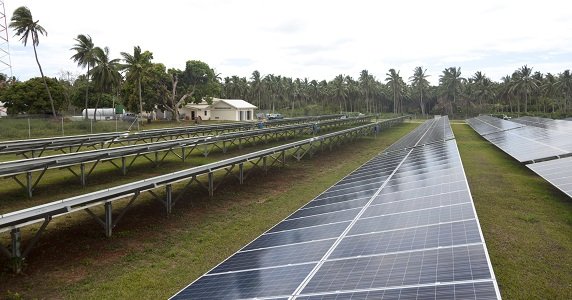Saving Fuel in Asia Pacific: First PV Diesel Hybrid System in Operation

Two colleagues from SMA Australia recently travelled to the South Pacific Island of Vava’u, Tonga to commission the SMA Fuel Save Controller for the first time in the Asia Pacific region. The country’s target is to supply 50 percent of the Kingdom’s power demand from renewable energy sources by the year 2020 and in an effort to reduce costs and offset carbon emissions, the island of Vava’u has now integrated photovoltaics into its diesel power generation system. SMA’s Tim Havron and Alexander Kaemmerer would like to share their experience with SMA’s Sunny Blog.
We were tasked to go on site and assist with the commissioning of the Fuel Save Controller on the island of Vava’u, Tonga. We were looking forward to being a part of this exciting project, not because it was on a beautiful Pacific island, but rather that it was to be the first time the SMA Fuel Save Controller to be commissioned in the Asia Pacific region.
Like on the big screen
As we descended into Vava’u, the view from the airplane was stunning. It was just like you see on the television or in holiday brochures; turquoise blue water, coral reefs, white beaches, many small islands surrounding big islands and tropical forest everywhere. But we soon realised the real Vava’u was poor and simple. Pigs, chickens and other animals freely ran around in the village of Neiafu, rubbish all over the streets, many houses looked ruinous and people drove about in scrappy cars. This deprived way of living really embedded why this island needed to save what money it has and have the ability of spending it on what it needs. Implementing solar PV seemed like a solution to help the island produce clean energy, reduce its CO2 emissions and most of all, save money on diesel.
To get it up and running
Our job was to configure the Fuel Save Controller (FSC) module, the inverter interface module (IFM) and the data acquisition module (DAQ). These modules need to communicate with each other via Ethernet, so our task was to configure IP addresses in each module, double check the communication between the modules, parameterise the DAQ with the correct values of the local current transformers (CT’s), communication with the local genset controller via the local network, and parameterise the IFM module and the Sunny Tripower 20000TLEE with special settings to operate with the FSC controller module. A major part of the commissioning was to start the PV system slowly and monitor the interaction with the gensets. We were continuously taking measurements of the whole operating system to ensure that a stable operation of the island power supply was guaranteed.
Huge savings for the island
Ingenero constructed the solar farm and we worked with them to get the system up and running. We also instructed and trained the local operator on what components are used for the FSC system and how to monitor the PV production. The system has the ability to offset as much as 70 percent of the island’s electricity demand during peak generation. This will be a huge saving for the island. Once we had successfully commissioned the FSC we were able to enjoy what the locals on the island had to offer. On the Friday night we were able to experience a traditional Tongan Feast called an ‘umu’. An umu is normally a Sunday tradition but they made a special allowance for us! The umu consists of a cow that is cooked underground in banana leaves on hot rocks for 12 hours. We were thrilled when we sat down to eat and there was enough food for 50 people. There were only seven of us there, so we were quite satisfied!
The impromptu leaving party
When our time came to leave Vava’u, we had the best farewell party ever. Tonga played in the Rugby League World Cup and beat Italy a couple of days earlier, and the famous player, Fuifui Moimoi, was on his way to his native Vava’u. The airport was full of music, cheer and dancing in anticipation for his arrival. Even though the celebrations weren’t for us, it was quite a spectacular way to leave.
This blog article was written by Tim Havron and Alexander Kaemmerer
For more information, please visit the following links
Official Press Release from SMA Australia

Excellent article and thank you for sharing the details of this solar energy application. I am really appreciate of SMA’s efforts to making such strong impacts in the world!